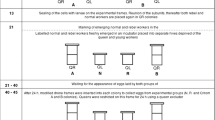Abstract
Anarchy, where honeybee workers produce males in the presence of a queen, is extremely rare in natural honeybee populations, suggesting that there are colony-level costs associated with being anarchistic. Yet, no significant costs have yet been identified. A possible reason for this may be that researchers have only focused on the behaviour of anarchistic workers, which have been shown to perform worker-tasks as do wild-type workers. Possibly, therefore, costs associated with anarchy should be sought in anarchistic queens and not workers. A potential cost could be a lower survival rate of eggs laid by anarchistic queens perhaps because their egg-marking signal is not as clear as that of a wild-type queen. In this paper, we determined the removal rate of eggs laid by anarchistic queens in standard worker-policing bioassays. Our results show that eggs laid by anarchistic queens are removed at a higher rate than eggs laid by wild-type queens. This does not seem to be due to differences in hydrocarbons found on the surface of eggs, as both egg types showed the same alkanes and alkenes in similar proportions. We postulate that higher removal rates of queen-laid eggs due to recognition errors may be one reason that anarchy is rare in natural honeybee populations.



Similar content being viewed by others
References
Barron AB, Oldroyd BP, Ratnieks FLW (2001) Worker reproduction in honey-bees (Apis) and the anarchistic syndrome: a review. Behav Ecol Sociobiol 50:199–208
Beekman M, Oldroyd BP (2003) Different policing rates of eggs laid by queenright and queenless anarchistic honey bee workers (Apis mellifera L.). Behav Ecol Sociobiol 54:480–484
Beekman M, Oldroyd BP (2005) Honeybee workers use cues other than egg viability for policing. Biol Lett 1:129–132
Beekman M, Ratnieks FLW (2003) Power over reproduction in social Hymenoptera. Phil Trans R Soc B 358:1741–1754
Carlson DA, Bernier UR, Sutton BD (1998) Elution patterns from capillary GC for methyl-branched alkanes. J Chem Ecol 24:1845–1865
Châline N, Ratnieks FLW, Burke T (2002) Anarchy in the UK: detailed genetic analysis of worker reproduction in a naturally-occurring British anarchistic honeybee, Apis mellifera, colony using DNA microsatellites. Mol Ecol 11:1795–1803
Collett D (1994) Modelling survival data in medical research. Chapman & Hall, London
Crozier RH, Pamilo P (1996) Evolution of social insect colonies: sex allocation and kin selection. Oxford University Press, Oxford
Dampney JR, Barron AB, Oldroyd BP (2004) Measuring the cost of worker reproduction in honey bees: work tempo in an ‘anarchistic’ line. Apidologie 35:83–88
Halling LA, Oldroyd BP (2003) Do policing honeybees (Apis mellifera) workers target eggs in drone comb? Insectes Soc 50:59–61
Hammond RL, Keller L (2004) Conflict over male parentage in social insects. PLos Biology 2:e248
Helanterä H, Sundström L (2005) Worker reproduction in the ant Formica fusca. J Evol Bio 18:162–171
Martin SJ, Beekman M, Wossler TC, Ratnieks FLW (2002) Parasitic Cape honeybee workers, Apis mellifera capensis, evade policing. Nature 415:163–165
Martin SJ, Châline N, Oldroyd BP, Jones GR, Ratnieks FLW (2004) Egg marking pheromones of anarchistic worker honeybees (Apis mellifera). Behav Ecol 15:839–844
Martin SJ, Châline N, Ratnieks FLW, Jones GR (2005) Searching for the egg-marking signal in honeybees. J Neg Res Ecol Evol Biol 2:1–9
Maynard Smith J, Szathmáry E (1995) The major transitions in evolution. Oxford University Press, Oxford, UK
Monnin T, Malosse C, Peeters C (1998) Solid-phase microextraction and cuticular hydrocarbon differences related to reproductive activity in queenless ant Dinoponera quadriceps. J Chem Ecol 24(3):473–490
Montague CE, Oldroyd BP (1998) The evolution of worker sterility in honey bees: an investigation into a behavioral mutant causing failure of worker policing. Evolution 52:1408–1415
Oldroyd BP, Ratnieks FLW (2000) Evolution of worker sterility in honeybees (Apis mellifera): how anarchistic workers evade policing by laying eggs that have low removal rates. Behav Ecol Sociobiol 47:268–273
Oldroyd BP, Smolenski AJ, Cornuet J-M, Crozier RH (1994) Anarchy in the beehive. Nature 371:749
Oldroyd BP, Halling L, Rinderer TE (1999) Development and behaviour of anarchistic honeybees. Proc R Soc B 266:1875–1878
Oldroyd BP, Ratnieks FLW, Wossler TC (2002) Egg-marking pheromones in honey-bees Apis mellifera. Behav Ecol Sociobiol 51:590–591
Ratnieks FLW (1988) Reproductive harmony via mutual policing by workers in eusocial Hymenoptera. Am Nat 132:217–236
Ratnieks FLW, Visscher PK (1989) Worker policing in the honeybee. Nature 342:796–797
Ratnieks FLW, Wenseleers T, Foster KR (2006) Conflict resolution in insect societies. Annu Rev Entomol 51:581–608
Reeve HK (1989) The evolution of conspecific acceptance levels. Am Nat 133:407–435
Wattanachaiyingcharoen W, Oldroyd BP, Good G, Halling LA, Ratnieks FLW, Wongsiri S (2001) Lack of worker reproduction in Apis dorsata. Insectes Soc 49:80–85
Weinberg R (1998) One renegade cell: The quest for the origins of cancer. Phoenix, London
Wenseleers T, Ratnieks FLW (2006) Comparative analysis of worker reproduction and policing in eusocial Hymenoptera supports relatedness theory. Am Nat 168:E163–E179
Acknowledgement
We would like to thank Tom Wenseleers for discussions and Michael Duncan for his help in the field. This research was supported by Australian Research Council grants to MB and BPO. Additional financial support was obtained via a University of Sydney Senior Research Fellowship to MB.
Author information
Authors and Affiliations
Corresponding author
Additional information
Communicated by R. Page
Rights and permissions
About this article
Cite this article
Beekman, M., Martin, S.J., Drijfhout, F. et al. Higher removal rate of eggs laid by anarchistic queens—a cost of anarchy?. Behav Ecol Sociobiol 61, 1847–1853 (2007). https://doi.org/10.1007/s00265-007-0424-0
Received:
Revised:
Accepted:
Published:
Issue Date:
DOI: https://doi.org/10.1007/s00265-007-0424-0




